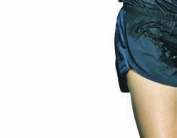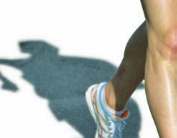Basic HTML Version








The
Loneliness
of the Long-
Distance
Racewalker
As master of an unusual sport, Trevor Barron
has had to enduremore thanmost on the
road to Olympic glory
BY CRISTINA ROUVALIS
BYTHETIMEHEWAS 15,
Trevor Barron couldwalk at a ferocious
clip. His hip-swiveling, arm-pumping style was so efficient it
propelled him past some joggers at his local track in suburban
Pi sburgh. But the same gait that made Barron a rising inter-
national star in the esoteric sport of racewalking also brought
hima lot of grief. Whenhe trained on a roadside path in a nearby
county park, guys passing by in pickup trucks would taunt
him. As he worked out at the middle school track, other kids
would sashay behind him, lampooning his form and yelling,
“Am I doing it right?”
It was only when Barron traveled all the way to Pharr, Texas,
a tiny hot spot of racewalking near theMexican border, that he
found respect and his own kind. The minute that A.C. Jaime,
the coach at the racewalking camp there, saw the tall, skinny
teen’s fluid stride, he had Barron demonstrate it to the other
racewalkers who had come from across the country to train in
the Rio Grande Valley.
Barronwas a star in Texas, and he was gi ed enough to com-
pete in international events. Yet when he returned home, hewas
still greeted with taunts. One day, mid-workout, Barron looked
up to see a woman making a video of him with her cellphone.
That was it. He’d had enough. Being an adolescent was tough
enough without becoming a YouTube joke.
Barron competed in onemore international meet, in Chebok-
sary, Russia, in 2008, and then quit the sport he loved. A er six
months, though, he missed his friends from around the world
so much that he returned to racewalking. Three years later,
at the shockingly young age of 18, he won the 20-km national
championship in 1:23:25.
Today Barron is considered a bright hope for the London
2012 Olympic Games, where a U.S. racewalking medal would
HEMISPHERESMAGAZINE.COM
•
APRIL 2012
61
the fan
JEFF SALVAGE/RACEWALK.COM
A STEP AHEAD
Racewalking’s
Olympic journey
Racewalking first sets foot on the Olympic stage in
1904
, at the St. Louis Games,
in the form of a half-mile walk in the “all-rounder” event (a forerunner of the
decathlon). It will be added as a stand-alone event at the London 1908 Olympic
Games, and, save for 1928, appear in every Olympic Games thereafter.

